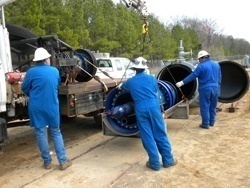
Pipeline pigging is a concept in pipeline maintenance that involves the use of devices known as pigs, which clean pipelines and are capable of checking pipeline conditions. This process is done without necessarily interfering with the flow of product in the pipe. Pipeline pigs are used in a number of different industries including oil & gas, lube oil, chemical plants, and hygienic applications such as pharmaceutical or food. Selecting the right pipeline pig for a particular application requires extensive experience, something that Inline provides.
The primary purpose of pipeline pigs is to make sure that the pipe is clean and free from obstruction. The pig is usually cylindrical or spherical to aid movement and efficient cleaning. As the pig moves through the pipeline, it can remove and possibly detect any build-ups within the pipe which can often lead to reduced performance, increased energy costs, and cause corrosion, which could lead to disastrous leaks and cracks in the pipe.
The pipeline pig is inserted into the pipe using a pig trap, which is typically oversized to accommodate the tight-fitting pig. A similar pig trap or receiver is located at the end of the pipe to receive the pig once it has traveled the length of the pipeline.
Media buildup in processing piping can cause transmittal slows or even plugging. Additionally, cracks or flaws in the line can be disastrous, causing leaks that hinder the bottom line and place workers and the environment at risk.
Pigs sweep the line by scraping piping surfaces and pushing debris ahead. They can perform many functions as they travel along a pipeline:
A pig will often make a sound as it travels through a pipe and if it doesn’t, a TX Transmitter can be installed into the pig. The pig can then be tracked through the pipe above ground using an RX101 Receiver or a GeoAmp XT Geophone. Apache pigPro signalers are a reliable indicator that the pig has passed a certain point on the pipeline.
Pigging systems are comprised of many pipeline pigging components. Exact parts vary by pigging system, but most applications include pig launchers, receivers, detectors, housings, propellant sources, and storage devices. Additional pigging parts are PLCs, HMIs, control software, supports, valves, and fittings.
All that being said, the actual effectiveness of a pigging system is the pig itself. A pig that’s undersized or made from a specific material may not perform reliably in a specific pipeline. That’s why Inline Services manufactures a wide array of pigging systems and components.
Inline Services has pigs for virtually every fluid transfer application. Any business that handles liquids can benefit from pigging systems. Examples include:
With vast experience and a proven track record, Inline Services is your source for high-performance pigging and liquid product recovery solutions. We help you achieve unparalleled productivity, profit, and environmental sustainability gains.
27731 Commercial Park Road
Tomball, Texas 77375
Tel: +1 -281.401.8142
Toll-Free: +1 -888.973.0079
Fax: +1 -281.401.8147
Simple Pigging System with Drop-Out
Simple Pigging System Closure
This animation demonstrates a simple pigging system closure. Inline’s VIPRS pig is positioned in the launcher as the product is run through the pipeline. At the end of the product run, the VIPRS pig is launched to remove all product from the line. The pig will trigger the indicator to alert that the pig has reached the end of the line.
Bi-Directional Pigging
This animation demonstrates Bi Directional Pigging. Inline’s VIPRS pig positioned in the launcher as product is run through the pipeline. At the end of the product run, the VIPRS pig is launched to remove all product from the line. When the VIPRS pig reaches the JB receiver, the propelling media is turned-off. When this happens the VIPRS pig is resting at the jail bar in the JB receiver; propellant is used on the receiver side of the pig to return it to the launcher.
Automated CIP System
This animation demonstrates a fully automated VIPRS bi directional pigging process system with CIP. Inline’s VIPRS pig is first positioned in the pig launcher. The product is pumped from the storage tank to the destination. The VIPRS pig is then launched to push the remaining product to the destination and captured in the VIPRS wash chamber at the destination station. Next, the CIP solution is pumped through the line to wash the chamber and pig. Finally, the pig pushes the CIP solution out of the piping and leaving the pig clean and ready for the next product run.